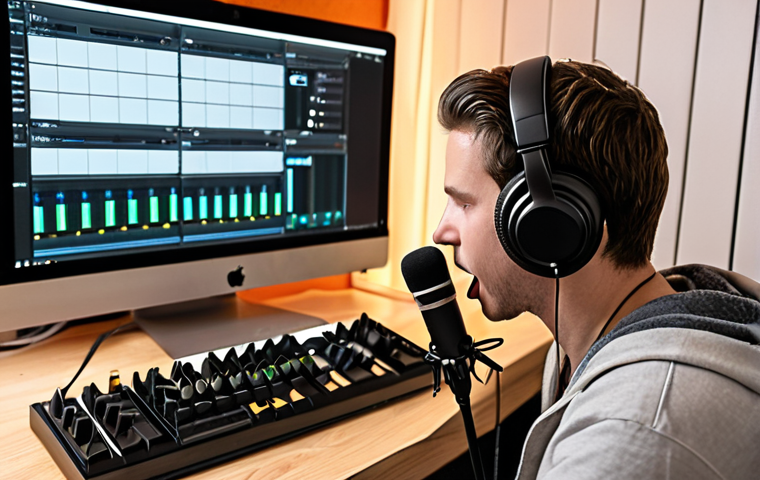Okay, here we go:Ever feel that itch to create something tangible, something that screams *you*? In a world saturated with digital noise, crafting a multimedia project can be incredibly fulfilling – and a killer way to learn new skills.
I’ve personally found it’s like throwing a bunch of creative ingredients into a pot and seeing what delicious stew comes out. From short films to interactive websites, the possibilities are truly endless, especially when you factor in the newest AI-powered tools for video editing and graphic design which, trust me, are game-changers.
But where do you even begin? Let’s dive in and find out exactly where to start!
Okay, here we go:
Unleash Your Inner Filmmaker: Crafting a Short Film

Lights, camera, action! Seriously, think about it: everyone has a story to tell. I remember back in college, I decided on a whim to make a short film with a group of friends.
We had absolutely no budget, but a ton of enthusiasm. We used a cheap digital camera, wrote a ridiculously melodramatic script, and filmed it all in one weekend.
The result? A hilariously awful masterpiece that we still laugh about to this day. The point is, don’t let perfection be the enemy of good.
Start small.
Brainstorming & Scriptwriting
Think about what truly interests you. Is it a dramatic story about unrequited love? A goofy comedy about mistaken identity?
Or maybe even a surreal experimental piece? Jot down any ideas that come to mind, no matter how silly they seem. Then, start outlining a simple plot.
Don’t worry about making it perfect. Just get the basic structure down.
Simple Production Techniques
You don’t need a fancy film crew or expensive equipment. Use your smartphone! Seriously, modern smartphones have incredibly powerful cameras.
Focus on good lighting and sound. Natural light is your best friend. And for sound, try to find a quiet location or invest in a cheap microphone.
Editing software like iMovie or DaVinci Resolve (the free version is excellent) can help you polish everything up. Remember that first film I mentioned?
Shot entirely on a phone.
Publishing & Sharing Your Work
Once your short film is complete, share it online! YouTube and Vimeo are great platforms for showcasing your work. You can also submit your film to local film festivals.
Who knows? You might just get discovered! The beauty of the internet is that it gives everyone a chance to be seen.
Become a Podcast Sensation: Starting Your Audio Journey
Podcasts are booming, and for good reason. They’re a fantastic way to share your thoughts, interview interesting people, and build a loyal audience. Personally, I listen to podcasts all the time, whether I’m commuting, doing chores, or just relaxing at home.
A friend of mine started a podcast about obscure historical facts, and it’s gained a surprisingly large following. She says the key is consistency and passion.
If you’re genuinely interested in what you’re talking about, people will tune in.
Finding Your Niche and Voice
What are you passionate about? What unique perspective can you offer? Maybe you’re an expert in vintage video games, or you have a knack for telling hilarious stories.
Find your niche and develop your unique voice. Authenticity is key.
Recording and Editing Like a Pro
You don’t need a fancy studio to create a great podcast. A decent USB microphone, a quiet room, and some free editing software like Audacity are all you need to get started.
Learn basic editing techniques, like removing background noise and adding intro/outro music. There are tons of tutorials online that can help you.
Distribution and Promotion
Once your podcast is recorded and edited, you’ll need to distribute it to platforms like Spotify, Apple Podcasts, and Google Podcasts. There are several hosting services that can help you with this.
Also, promote your podcast on social media, and engage with your listeners.
Crafting an Engaging Blog: From Zero to Hero
Okay, so you want to be a blogger, huh? Awesome! It’s a long game, for sure, but can be super rewarding.
I remember when I started my first blog. I had no idea what I was doing. My writing was clunky, my design was awful, and nobody read it.
But I kept at it, learned from my mistakes, and eventually started to see results. The key is to provide value to your readers and to be consistent with your posts.
Choosing Your Platform and Niche
WordPress, Blogger, and Medium are all great options. Choose a platform that suits your needs and technical skills. Then, decide on a niche.
What are you passionate about? What knowledge can you share? A focused blog is more likely to attract a dedicated audience.
Writing Compelling Content
Write content that is informative, engaging, and valuable to your readers. Use clear and concise language. Break up your text with headings, subheadings, and images.
Be authentic and let your personality shine through.
SEO Optimization and Promotion
Learn the basics of SEO (Search Engine Optimization) to improve your blog’s visibility in search results. Use relevant keywords, optimize your titles and descriptions, and build backlinks.
Promote your blog on social media and engage with other bloggers in your niche.
Interactive Web Design: Bringing Your Vision to Life
Want to build something that users can actually *interact* with? Get into web design! I used to think web design was some arcane art reserved for tech wizards.
But then I took an online course and realized it’s actually quite accessible. And when you start using code to bring ideas to life, it’s a serious dopamine hit.
Understanding HTML, CSS, and JavaScript
These are the building blocks of the web. HTML provides the structure, CSS handles the styling, and JavaScript adds interactivity. There are tons of free online resources that can teach you the basics.
Start with HTML and CSS, and then move on to JavaScript.
Creating User-Friendly Interfaces
Focus on creating interfaces that are intuitive and easy to use. Think about the user experience. How can you make it as simple and enjoyable as possible for people to navigate your website or application?
Keep the visual hierarchy clear and use simple layouts.
Responsive Design Principles
Make sure your website or application looks good on all devices, from desktops to smartphones. Use responsive design techniques to ensure that your content adapts to different screen sizes.
This is essential in today’s mobile-first world.
Designing Eye-Catching Graphics: Visual Communication is Key
In today’s visual world, knowing how to design eye-catching graphics is a valuable skill. Whether it’s for social media, websites, or presentations, great visuals can make a huge difference.
I always struggled with graphic design. I thought you had to be a naturally talented artist to create anything decent. Then I discovered Canva and other user-friendly design tools.
They made it so easy to create professional-looking graphics, even without any prior experience.
Mastering Basic Design Principles
Learn about color theory, typography, and composition. These are the fundamental principles that underpin all good design. There are many free resources online that can teach you these concepts.
Understanding these principles will help you create visuals that are both aesthetically pleasing and effective.
Utilizing Design Software and Tools
Canva, Adobe Photoshop, and Adobe Illustrator are all popular choices. Choose a software that suits your needs and budget. Canva is a great option for beginners, while Photoshop and Illustrator offer more advanced features.
Creating Visuals for Different Platforms
Different platforms have different requirements and best practices. Learn how to create visuals that are optimized for social media, websites, and other platforms.
Pay attention to image sizes, file formats, and aspect ratios.
Coding a Simple Game: Gamification for Fun and Learning
Ever wanted to create your own video game? It’s easier than you might think! I’ve always been fascinated by video games.
But I never thought I could actually create one myself. Then I discovered Scratch, a visual programming language designed for beginners. It was so easy to use, and I was able to create a simple game in just a few hours.
It was an incredibly rewarding experience.
Choosing a Game Engine
Scratch, Unity, and GameMaker Studio 2 are all popular choices. Scratch is great for beginners, while Unity and GameMaker Studio 2 offer more advanced features.
Pick one that suits your needs and skills.
Understanding Game Mechanics
Learn about game loops, collision detection, and user input. These are the fundamental concepts that underpin all video games. There are many free tutorials online that can teach you these concepts.
Creating Engaging Gameplay
Focus on creating gameplay that is fun, challenging, and rewarding. Think about the player experience. How can you make it as enjoyable as possible for people to play your game?
Experiment with different game mechanics and level designs. Here is a table summarizing the tools, skills, and platforms you might want to consider:
| Project Idea | Essential Skills | Recommended Tools | Publishing/Sharing Platforms |
|---|---|---|---|
| Short Film | Scriptwriting, filming, editing | Smartphone, Microphone, iMovie, DaVinci Resolve | YouTube, Vimeo, Film Festivals |
| Podcast | Audio recording, editing, interviewing | USB Microphone, Audacity, Podcast Hosting Services | Spotify, Apple Podcasts, Google Podcasts |
| Blog | Writing, SEO, Social Media Marketing | WordPress, Blogger, Medium, Google Analytics | Social Media, Email Marketing |
| Web Design | HTML, CSS, JavaScript, UI/UX Design | VS Code, Chrome DevTools, Figma | GitHub Pages, Netlify |
| Graphic Design | Color Theory, Typography, Composition | Canva, Adobe Photoshop, Adobe Illustrator | Social Media, Website |
| Game Development | Coding, Game Mechanics, Level Design | Scratch, Unity, GameMaker Studio 2 | itch.io, Steam |
Wrapping Up
So, there you have it! A whirlwind tour of creative projects you can tackle, no matter your experience level. The most important thing is to just start. Don’t be afraid to experiment, make mistakes, and learn from them. The world needs your unique voice and your creative vision. Go out there and make something amazing!
Helpful Tips & Resources
1. Skillshare & Udemy: These are your go-to platforms for online courses in just about anything – from coding and design to filmmaking and podcasting.
2. Canva’s Design School: Check out Canva’s free design tutorials. You’ll learn about color theory, typography, and basic design principles.
3. Local Meetups: Search for local groups or meetups related to your project. It’s a great way to network, learn from others, and find collaborators.
4. Your Local Library: Don’t underestimate the power of a good library! You can find books, magazines, and even online resources for free.
5. YouTube Channels: YouTube is a treasure trove of free tutorials and educational content. Search for channels related to your project, and start learning!
Key Takeaways
- Start with projects that genuinely excite you. Your passion will fuel your motivation and keep you going.
- Don’t aim for perfection right away. Focus on learning and improving with each project.
- Utilize the vast array of free resources available online and in your community.
- Embrace failure as a learning opportunity. Don’t be afraid to make mistakes and experiment.
- Share your work with the world and connect with other creatives. Building a community can be incredibly rewarding.
Frequently Asked Questions (FAQ) 📖
Q: I’m totally new to this. What’s the absolute easiest multimedia project I can start with to get my feet wet?
A: Honestly, creating a simple slideshow with voiceover is fantastic. I’m serious! Think about a recent vacation.
Gather some of your favorite photos, write a short script sharing memories from the trip (funny anecdotes are gold), and then use free software like Google Slides or even iMovie to combine them.
The voiceover element adds a personal touch and bam – you’ve got a multimedia project. I’ve done this a couple times and it really is simple but satisfying.
It gives you a feel for combining visuals, audio, and narration without getting overwhelmed.
Q: Okay, slideshows sound doable, but I’m a bit more ambitious. I want to try video editing. I’ve heard it’s crazy complicated, is that true?
A: nd what software should I even use? A2: Video editing can seem intimidating, but trust me, it’s not brain surgery. The key is starting small.
Don’t jump into making a feature film right away! As for software, if you’re on a Mac, iMovie is surprisingly powerful and completely free. If you’re on Windows, check out DaVinci Resolve – the free version is incredible and used by many pros.
I recently used DaVinci Resolve to edit a short skateboarding video with my nephew and it was a blast to try all sorts of effects. Start with basic cuts, transitions, and maybe add some background music.
There are tons of free tutorials on YouTube to walk you through the basics of whatever software you choose. Just search “[Software Name] Beginner Tutorial”.
Q: E-E-
A: -T is important, right? So, how can I make sure my multimedia project demonstrates my expertise and authority, even if it’s just for fun? A3: Absolutely!
Even for a personal project, think about adding elements that highlight your unique perspective. If you’re creating a travel video, focus on your personal experiences and insights rather than just showing generic tourist spots.
Share hidden gems you discovered or offer unique tips based on your experience. For example, if you’re making a cooking video, don’t just recite a recipe; share your own variations, explain why you prefer certain techniques, and maybe even tell a story about the first time you made the dish.
By weaving in personal anecdotes and insights, you add a layer of authenticity and expertise that will resonate with your audience. I always throw in little jokes or stories when I create something and that always seems to get me positive feedback.
📚 References
Wikipedia Encyclopedia
구글 검색 결과
구글 검색 결과
구글 검색 결과
구글 검색 결과




